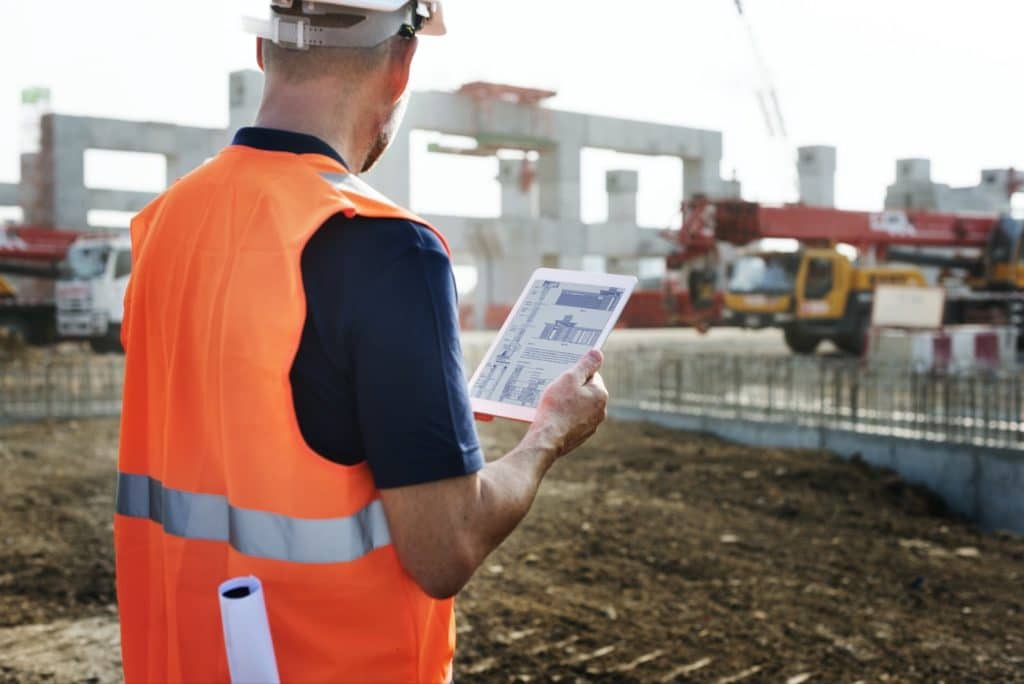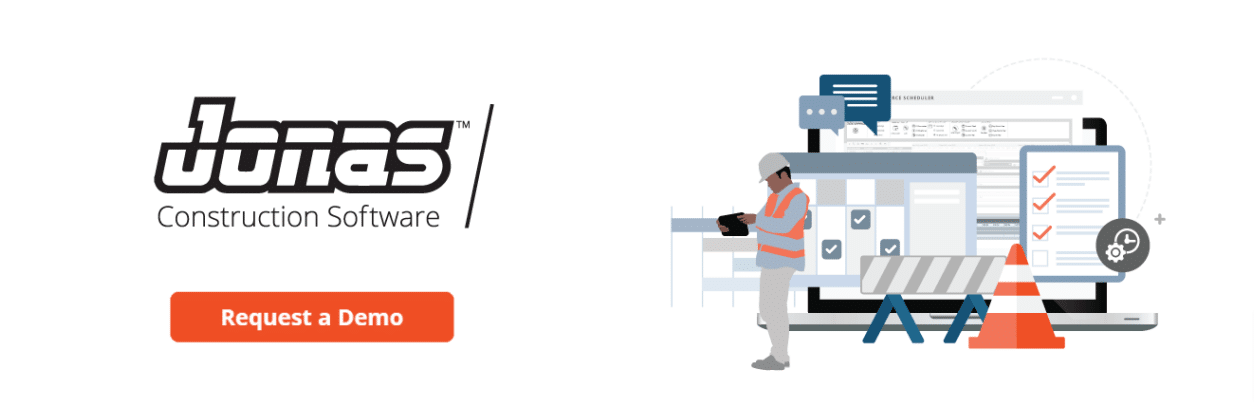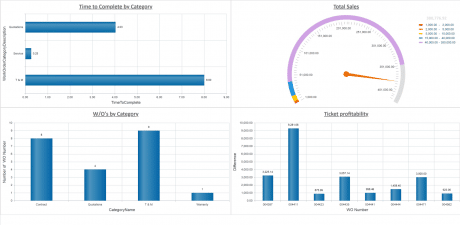Last Updated on July 17, 2023

Every construction project, from the small bathroom renovation to the towering skyscraper, has a similar process. Each project requires planning and design. You also need to consider inventory, resources, and manage supplies, the actual construction of the project needs to be managed, and there will be post-construction details to tie-up.
Every construction project, regardless of size, benefits from a solid plan and a great project manager who is familiar with construction project management. To build the right plan for your construction project it is helpful to understand the construction process.
The construction process is the detailed steps required to complete your construction project. This process can be broken down into five phases – planning/design, pre-construction, procurement, construction, and post-construction. Depending on the size and scope of the project, each phase has its own set of challenges.
While construction projects may vary in size, the number of stakeholders, budget, and delivery date, one thing remains certain: Construction projects are always a long and demanding process with lots of moving parts. That’s why having the right project management tool at hand is important.
The good news is that with construction-specific project management software, the management of the different project phases can now be done easier and more efficiently. Let’s take a look at the five phases of a construction project and discover how the project management technology helps during each phase.
1. The Initiation Phase

The initiation phase is one of the most important aspects of construction project management. It encompasses all of the steps you must take before a project is approved and any planning begins.
Usually, there are three different steps in this initial design stage:
- Programming and feasibility: The planning team outlines the objectives and goals of the project through a feasibility study or business case. Decisions made at this stage include how large the building will be, how much space will be used, and how many rooms will be needed. Once these decisions are made, a project initiation document (PID) is created.
- Schematic design: At this step, the team produces a sketch showing the space as well as materials, colors, and textures. This information will be used during the design development to research the equipment needed and materials to be used.
- Contract documents: These documents contain the final drawings and specifications. These documents are used by those placing bids to work on the project.
Common Challenges in the Planning/Design Phase
Miscommunication is the biggest hindrance to starting a project off on the right foot. To develop the right design, project managers need to be in touch with the client, designer, architect, suppliers, and engineers. This is impossible without a reliable communication channel.
Another big challenge at the first phase of construction project management is undefined goals. Sometimes project stakeholders don’t know what exactly they want, or they can’t agree on materials. When the goals aren’t clear, it’s difficult to manage the project.
How Software Can Help with Planning/ Design
Construction planning has been greatly revolutionized, thanks to technology. The integrated construction management software makes it possible for project managers and stakeholders to identify likely obstacles so they can work on coming up with remedies even before the project starts. Construction scheduling software makes it easier to record data agreed upon during the planning phase and makes data sharing more accurate and up-to-date.
When all the data from the different stakeholders is centralized, the risk of human error is reduced and the whole team stays on the same page.
Drawing up the schematic is usually a complicated process, but it becomes easier when you can gather all the necessary documentation in one place. When the information is instantly updated, the planning team can create an accurate picture of how the job will progress.
2. The Pre-Construction Phase
When the bidding is completed and the contractor has been chosen to do the work, the next stage of a construction project begins. Before they ‘break ground,’ as the industry saying goes, the project team is put together. Most commonly, the following team members are included:
- Contract administrator
- Project manager
- Superintendent
- Field engineer
- Health and safety manager
At this stage, a project team prepares the construction site before the work begins. The site must be ready for construction, which might mean dealing with environmental issues, such as soil testing. When the site examination is complete, all plans and findings will be reviewed by the city authorities.
Once the strategic plan has been created, and the budget, design, and timeline are finalized, the project team begins to gather the labor and resources required for construction.
Common Challenges in the Pre-Construction Phase
A lot of unknown variables can appear if there’s no clear picture of what the project is going to look like, how it is going to get done, and when it will be completed. Without evaluating all possible scenarios upfront, the client can have unrealistic expectations. Insufficient preparation increases the risk of issues and hinders your risk management when the project is underway.
During the pre-construction phase, there are numerous legal issues, permits, and building codes involved. Without proper paperwork management, documentation storage and control can become another challenge.
How Software Can Help with Pre-Construction
At this stage, key team members build a project timeline schedule that creates a logical workflow. Having reliable scheduling software ensures smooth sailing as the project unfolds.
When the project team has been assembled, team members coordinate their responsibilities around everyone’s schedules. That’s when various scheduling views become handy, as teams switch between Gannt charts, calendar, and timeline.
Construction document management becomes important at this stage. Once securing permits or entitlements, all project-related documents are stored in one centralized location and are accessible by anyone.
3. The Procurement Phase

During this phase, the project team orders, purchases, or rents all the materials, tools, and services necessary to complete the project.
This stage of the construction project can be more or less challenging depending on the scope of the project, the resources availability, and the start date.
Common Challenges in the Procurement Phase
Miscommunication is one of the most common challenges in this phase. The client might have failed to define their expectations clearly, the contractor faced shipping delays or the wrong product being ordered, and the construction manager gets caught in the middle. It doesn’t matter if the project is a living room remodel or a new multi-million-dollar golf club, without transparent, complete information, the project is in danger.
Without clear communication for purchasing and inventory management, your staff could be overspending, double-buying, or purchasing outside the project’s requirements. This creates even more expense through replacement costs and lost time.
How Software Can Help with Procurement
A centralized and comprehensive procurement solution will reduce confusion and distress. When it comes to budgeting, you will be able to combat rogue spending and eliminate the need for a one-off buy at your local hardware shop. And when unexpected costs happen, your budget will be updated accordingly. Seamless communication with all stakeholders on one platform makes job costing, more transparent, and ultimately, more accurate.
Construction-specific project management software keeps all stakeholders up-to-date and facilitates team collaboration instantly with mobile access to contract documents, framework agreements, and spending data. As your project evolves, your timetable keeps pace with automated approvals.
When done correctly, procurement improves efficiency and reduces wastage. When done incorrectly, the procurement process can cause delays and waste that negatively affect the project budget. Time is money, and with the right software, you stay on top of both.
4. The Construction Phase

This is the project execution phase where all the planning will pay off. Before any construction begins, the project manager, design, and engineering teams have already put a lot of effort to make a project successful. During the construction phase, the center stage belongs to the contractor and subcontractors.
As the hub of communications for the project, the construction manager and contractor will transition the project into actual construction. The architect, engineers, and project manager perform quality control inspections, respond to Requests for Information (RFIs), and review and approve technical submittals. The priority is to ensure that the project is delivered by the contractor as designed.
Common Challenges in the Construction Phase
If the project team has diligently and properly executed the planning and preconstruction phases, construction should progress smoothly. But even with proper planning, there are still challenges. One significant challenge for the Construction Phase is mismanaged scheduling.
Poor scheduling is a common challenge at this point. Since most physical construction occurs linearly, one construction team can be waiting for another team to complete their part of the project. Each worker may have their own schedule, too. Without proper scheduling, busy crew members can only guess what activities they should do for the day. Bad planning and scheduling can lead to delays and budget overruns.
Lack of communication or missing information can also be a challenge in this phase. Invoices or inventory lists could go missing, revisions to the design or blueprints may not be communicated to everyone efficiently, delays are not managed optimally, there are countless challenges in the construction phase, and most of them are foreseeable and easily rectified with the right software.
How Software Can Help with Construction
During the construction phase, specialized software supports on-site project management through project monitoring. The construction manager will use software to oversee quality control, monitor the contractor’s safety program, monitor contractors’ project performance, coordinate permits, technical inspections, and monitor RFIs and submittals to ensure they are on track.
Payroll software helps maintain the schedule of payment and a process to deliver the funds. By keeping this information transparent, not only do you meet financial obligations, but also maintain a happy and productive workforce.
From administering construction contracts and managing the budget and schedule to certifying contractor progress payments and approving payment requests, intelligent construction management software keeps the entire project on track.
5. The Post-Construction/ Closeout Phase
The project closure phase of the project is the last step in the long process of designing and completing a construction project. Now that all the work on the job site has been completed, the project will come to a close.
Project close-out involves more than just completion of the punch list. The resources required for the project are demobilized, equipment rentals are returned, the worksite is cleaned up, and subcontractors that have completed their jobs move onto other projects.
From the project management perspective, it’s a good time to carry out a post-project review which could help detect any tasks that weren’t completed, analyze any challenges and put together a list of informative insights for the future.
Common Challenges in the Post-Construction/ Closeout Phase
Closeout is an essential phase when all the equipment and labor must be managed efficiently to avoid costly delays.
Construction projects generate a substantial paper trail. Assembling project-related documentation and getting it in the hands of the owner is one of the final steps of the project management team. Paper-based document management can lead to all sorts of errors and gaps in documentation, so using a cloud-based document management system is important throughout the project.
How Software Can Help with Post-Construction/ Closeout
Closeout can be done faster by automating and tracking the collection of documents. Drawings, warranties, photos, training videos — the list of post-construction essentials goes on. With the right software, you can deliver key information in a mobile-friendly format so it can be accessed anytime, anywhere.
Document management plays the center stage during the closeout. The documents created during a construction project can be useful for any number of reasons for the owner’s team and are an important reference tool that the owner can refer to months or even years after project completion if needed. When all documents about each job are stored in a central location, delays and errors are minimized.
Jonas Construction Helps Project Managers Through Every Phase of Construction Project Management
Effective construction project management is nearly impossible without industry-specific software which allows project managers to:
- Perform accurate job costing.
- Manage project budgets.
- Create reliable schedules and share them with subcontractors and clients.
- Automate project updates.
- Manage contracts and change orders.
- Stay on top of the deadlines with work-in-progress reports.
- Manage equipment and inventory.
- Allow your subcontractors, clients, and other stakeholders to access the information they need when they need it.
Technology makes our lives easier and more efficient in so many areas – and the construction industry is no exception. Consider how much faster it is to use a chainsaw instead of a handsaw. If you feel it’s time to offload the heavy lifting of project management, consider making the move to the fully integrated Jonas construction management software.







